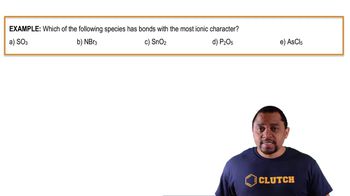Although I3- is a known ion, F3- is not. (b) One of your classmates says that F3- does not exist because F is too electronegative to make bonds with another atom. Give an example that proves your classmate is wrong.
The hypochlorite ion, ClO-, is the active ingredient in bleach. The perchlorate ion, ClO4-, is a main component of rocket propellants. Draw Lewis structures for both ions. (b) What is the formal charge of Cl in the perchlorate ion, assuming the Cl—O bonds are all single bonds?
 Verified step by step guidance
Verified step by step guidance
Verified video answer for a similar problem:
Key Concepts
Lewis Structures

Formal Charge

Ionic and Covalent Bonds

Although I3- is a known ion, F3- is not. (c) Another classmate says F3- does not exist because it would violate the octet rule. Is this classmate possibly correct?
Calculate the formal charge on the indicated atom in each of the following molecules or ions: (a) the central oxygen atom in O3 (b) phosphorus in PF6- (c) nitrogen in NO2 (d) iodine in ICl3 (e) chlorine in HClO4 (hydrogen is bonded to O).
The hypochlorite ion, ClO-, is the active ingredient in bleach. The perchlorate ion, ClO4-, is a main component of rocket propellants. Draw Lewis structures for both ions. (c) What is the oxidation number of Cl in the hypochlorite ion? (d) What is the oxidation number of Cl in the perchlorate ion, assuming the Cl—O bonds are all single bonds?
The following three Lewis structures can be drawn for N2O:
(a) Using formal charges, which of these three resonance forms is likely to be the most important?
The following three Lewis structures can be drawn for N2O:
(b) The N—N bond length in N2O is 1.12 Å, slightly longer than a typical N≡N bond; and the N—O bond length is 1.19 Å, slightly shorter than a typical N═O bond (see Table 8.4). Based on these data, which resonance structure best represents N2O?
